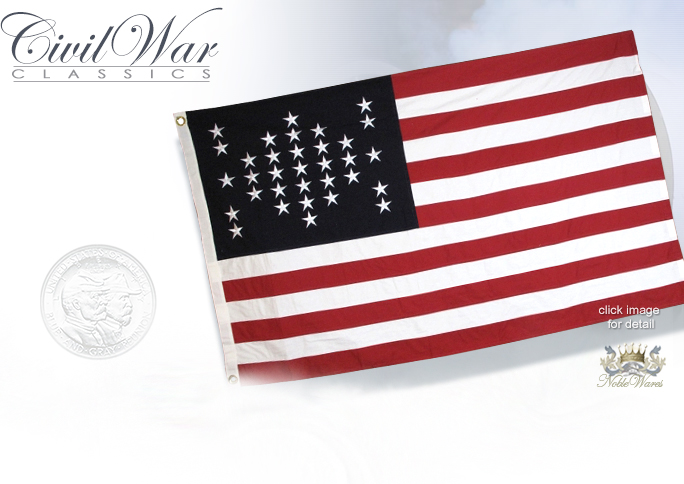CIVIL WAR 33 STAR FORT SUMTER FLAG HUC35P China HUC35P China
The Fort Sumter Flag is a historic United States flag with a distinctive, diamond-shaped pattern of 33 stars. The flag was lowered by Major Robert Anderson on April 14, 1861 when he surrendered Fort Sumter, in the harbor of Charleston, South Carolina, at the outset of the American Civil War. This flag was a widely known patriotic symbol for the North during the war. The original Fort Sumter Flag is still on display at National Park Service.

Known for its weather resistance, this historic 33 star Fort Sumter Union Civil War flag is made of 100% weather resistant "super polyester" which allows excellent durability and delivers a silky sheen with high resistance to fading and wear. Finished with a heavy nylon heading, and sturdy brass grommets, this famed 3'x5' Union flag has excellent fly ability; silky-looking, knitted polyester fabric, this flag is suitable for outdoor use and is of much higher quality than a standard printed polyester flag. |
|

• 100% weather resistant polyester
• Rich, Vibrant Colors Resistant to Fading
• 3' x 5'
• Sturdy Nylon Header
• Durable Brass Grommets
• Printed Stars Field and Stripes
 On April 14, 1865, four years to the day after the surrender and as part of a celebration of the Union victory, Anderson (by then a major general) raised this flag in triumph over the battered remains of the fort. On April 14, 1865, four years to the day after the surrender and as part of a celebration of the Union victory, Anderson (by then a major general) raised this flag in triumph over the battered remains of the fort.

The Rev. Henry Ward Beecher was the principal orator at the 1865 celebration, and gave a lengthy speech, as was the custom of the day. He said in conclusion: "On this solemn and joyful day, we again lift to the breeze our fathers’ flag, now, again, the banner of the United States, with the fervent prayer that God would crown it with honor, protect it from treason, and send it down to our children.... Terrible in battle, may it be beneficent in peace [and] as long as the sun endures, or the stars, may it wave over a nation neither enslaved nor enslaving.... We lift up our banner, and dedicate it to peace, Union, and liberty, now and forevermore." — Rev. Henry Ward Beecher

Later that night President Lincoln would be shot at Ford's Theatre.
|